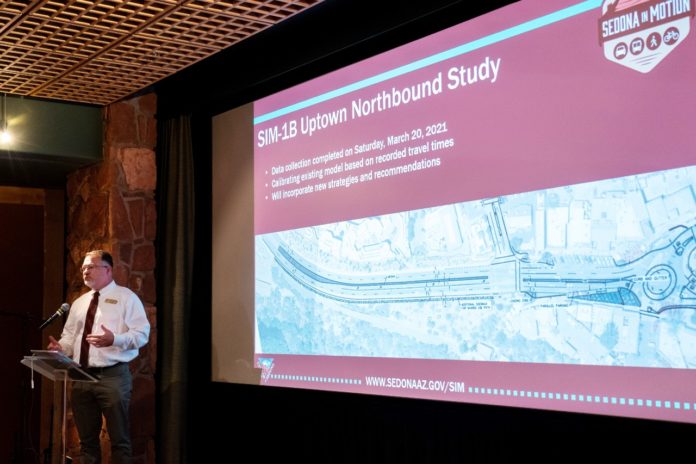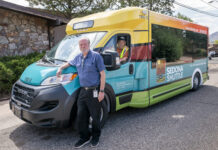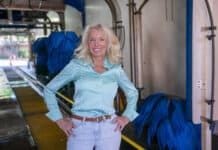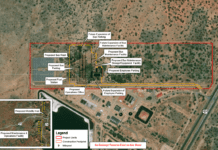
Think of it as the CliffsNotes version of what the city of Sedona, U.S. Forest Service, Big Park Regional Coordinating Council and Northern Arizona Healthcare have been up to lately.
On Wednesday, Aug. 25, the Sedona Chamber of Commerce hosted a Community Pulse, which it plans to do again in February.
The event, co-sponsored by the electricity utility Arizona Public Service and held at Mary D. Fisher Theatre, brought together representatives from each of the above to update the public on where things stand on certain topics and to answer questions from the audience.
The following is a synopsis of the discussions given by the guest speakers:
■ Sedona Deputy City Manager Joanne Keene
Keene was there to discuss a topic on the minds of many: Workforce and affordable housing. She provided data from a 2018 housing study that showed Sedona workforce needs as well as the entire Verde Valley.
“Obviously we’re going to see some significant changes since 2018,” she said. “As we all know, it’s just gotten worse since 2018.”
She said based on that study, in Sedona, Clarkdake and Cottonwood, nearly 40% of workers in the workforce are what’s called, “cost burdened,” where residents pay more than 30% of their income in housing.
In Sedona alone, that number was 42.5% for those paying at least 30% of their income on housing with 22.7% paying more than 50% on housing alone.
“These statistics are pretty staggering,” she said. “And again, these figures
are from 2018, so imagine what it’s like today.”
She also discussed the city’s effort to create workforce housing with the approved Sunset Lofts workforce housing project and a plan to eventually add additional housing in an apartment adjacent to city hall. That’s in addition to the proposed down payment assistance program through the city.
■ City Engineer Andy Dickey
Dickey discussed the ongoing Sedona in Motion transportation program, of which several projects have been fully completed in Uptown but with several other projects in the works.
He said several shared-use pathways designed for residents have been completed in various neighborhoods including Sanborn Drive to Thunder Mountain Road.
Once complete, there will be 8 miles worth of shared-use pathways within in Sedona city limits.
Dickey also touched upon other SIM projects such as the Forest Road connector, a pedestrian walkway underneath the State Route 179 bridge near Tlaquepaque, a proposed parking garage on Forest Road and connectors to Brewer Road.
■ Sedona Transit Administrator Robert Weber
Weber said an overall public transit project could take upwards of nine years to complete.
However, because of the amount of traffic in the Sedona area and parking issues at area trailheads this past spring, the installation of temporary trailhead shuttle locations have been moved up by as much as five years. Those shuttle hubs are being looked at on Brewer Road, possibly Posse Grounds Park and other yet-to-be determined locations throughout the city.
“We’re looking at this through two lenses,” he said. “The first is short-ranged planning, which we hope to implement by March.”
He went on to say, “On the long-ranged side, the city currently does not have a transit or maintenance facility. We will have to build one. But, we want to do it in a way that will support a future sustainable fleet.”
■ District Ranger Amy Tinderholt of the Red Rock Ranger District
Off-highway vehicles, or OHVs, have been a hot topic for years. But it’s only been within the last decade that the U.S. Forest Service has designated specific roadways for off-road vehicles. Prior to that, they were allowed to go just about anywhere on forest service land.
Now, all uses must remain on designated routes. In recent years, 11 areas were identified for OHV use by the public. These areas have be used by off-road enthusiasts for years but now, users are being directed to them and provided education and signage.
Next up is the USFS partnering with Yavapai County Sheriff’s Office, Arizona Game & Fish Department and the state’s OHV committee to seek funds for staffing.
These employees would patrol the areas, provide maintenance and educate off-road users. Another partnership includes working closely with OHV rental businesses to ensure that laws are abided by, while their customers have a good time.
Tinderholt said partnerships is the key to any success the USFS has in the area, specifically the one they have with the city of Sedona and chamber of commerce.
“It is a really strong partnership,” she said.
■ Red Rock Ranger District Recreation Staff Officer Chris Johansen
In recent times, Forest Service Road 525, west of Sedona, has become a very popular area for dispersed camping. Right now there are no designated campgrounds nor spaces nor are there any amenities such as water or restrooms.
Those staying on USFS land are allowed up to 14 days. At times there have been upwards of 200 campers in that area.
But that is going to change, Johansen said, with the West Sedona Dispersed Camping project, which is in the works. In the first phase, which will begin later this year, there will be a temporary emergency closure of Forest Road 525.
Now, there is no rhyme or reason in terms of the dispersed camping but the plan calls for eight designated areas, along Forest Service Roads 89B and 525, marked off by large boulders and signs. Campers will need to stay within these designated areas, with those who don’t being subject to fines. This plan, he said, will help nature and wildlife recover, and when completed, will assist enforcement.
“We’re still providing camping opportunities,” he said. “The eight spots will be all different sizes. The largest can hold 35 spaces. In all, there will be 150 to 200 campsites.”
■ Big Park Regional Coordinating Council President Camille Cox
Cox said she appreciated the fact that the Village was asked to be represented in the event and instead of sharing what the BPRCC is doing these days, wanted to give more of an introduction.
“I think it makes sense to discuss common problems and collaborate on solutions,” she said. “But it’s really important the collaborators be familiar with one another.”
BPRCC is a nongovernmental body that says it represents the VOC — which has a 2020 population of 6,128. It serves no legal nor official advisory role with Yavapai County, but collectively brings forward community concerns.
“Although we have a proud self identity within our community, our mail comes to us with a Sedona address and the outside world really sees us as indistinguishable from Sedona,” she said. “We share a fire district, library, a school district, arts community, fragile Oak Creek waterways and a world-renowned red rock destination. And absolutely, we have a shared economy.”
■ Northern Arizona Healthcare President and CEO Flo Spyrow
Spyrow focused on a trio of topics: COVID-19, NAH’s oncology program in Sedona and the proposed NAH Health Village near Fort Tuthill, outside of Flagstaff.
“COVID continues to be a major issue for us to address,” she said. “It has a lasting impact across our country. All the stats are moving up.”
Spyrow said while vaccines will not prevent one from getting COVID, they do prevent people from becoming significantly ill and dying from COVID.
On the topic she added that in Yavapai County 46% of the population is fully vaccinated and in Coconino County, 55%. Typical “herd immunity” for an infectious disease is 70% within a community.
In terms of oncology care, Spyrow said NAH is looking at the topic system-wide and through those efforts they have recruited a number of physicians to expand the program, which includes Sedona.
“We’ve looked at a variety of avenues on how we provide more comprehensive cancer services throughout our region,” she said.
As for the health village, which will be debated by the Flagstaff City Council, if approved, it will be a state-of-the art facility, she said. Currently, Flagstaff Medical Center is the only Level 1 trauma center north of Maricopa County, serving 50,000 square miles. On any given day, she said 60% of their patients are from outside the Flagstaff area.
“We feel an obligation to modernize and live up to the trust and needs of our service area across Northern Arizona in order to keep care close to home,” she said.
The video of the event can be found at sedonachamber.com.





















